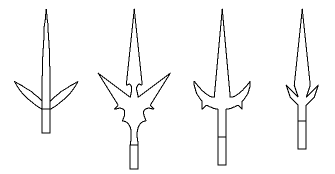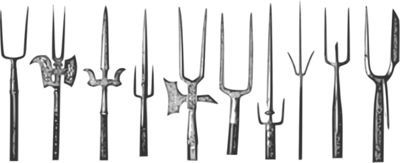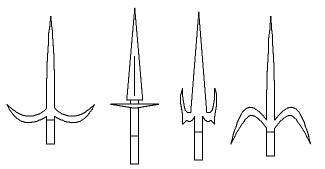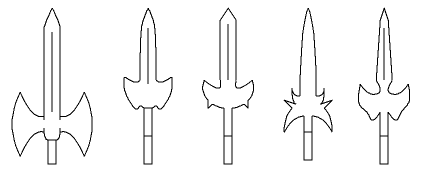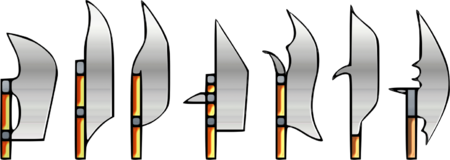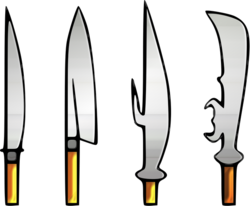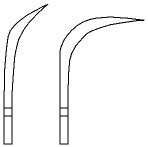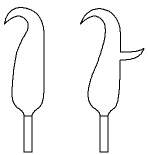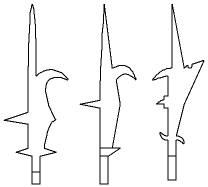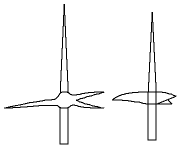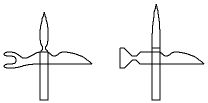Polearm
A polearm is literally a weapon on a pole. There is an abundance of polearm types in NetHack. This is another feature of the game that echoes early editions of the Dungeons & Dragons games, which were infamous for giving stats for many exotic polearms, while describing none of them.
Monsters will attempt to use polearms in the following order: halberd, bardiche, spetum, bill-guisarme, voulge, ranseur, guisarme, glaive, lucern hammer, bec de corbin, fauchard, partisan, followed by the lance; and so this list is roughly from best to worst. Of course, polearms can only be used by strong monsters without a shield.
The lance is, in real life, a polearm, but in NetHack it uses the lance skill instead of the polearm skill, due to its very different usage: by mounted soldiers instead of against them.
Generation
Collectively, polearms make up about 6.4% of all randomly generated weapons (on the floor, as death drops, or in shops). The probabilities of each type range from 0.4% to 0.8%.
A few types of polearms are more common because they appear in the starting inventory of certain monsters. Ranseurs, partisans, glaives, and spetums are the usual starting weapons of trolls.[1] Lucern hammers may also be generated as a fall-back starting weapon for strong monsters that lack default weapons.[2]
Watchmen and soldiers in the Yendorian Army often start with a random polearm.[3]
Strategy
Polearms are capable of attacking enemies from two squares away, but the procedure for using them is different from other weapons. A polearm must be wielded (like any weapon), and then applied via the a command each time you want to strike. This is referred to as pounding; consult that article for a full discussion. Simply walking into an opponent, as with ordinary melee weapons, will have decidedly sub-optimal effects; you will deal only d2 damage, with no bonuses, and will not train polearm skill.
If you are mounted, you may use polearms for melee attacks with full effectiveness. Polearms deal less damage than other two-handed weapons in most circumstances, but they are an attractive option for roles such as Rangers and Wizards, who can ride but are restricted in the better two-handed weapon skills, and the ability to transition from pounding to melee without switching weapons grants distinct tactical advantages.
One of the great uses of polearms is not for fighting mounted opponents, but for fighting sea monsters, since staying two squares away from water makes a character immune to their drowning attack. If you have no simpler method for dealing with the sea monsters, it can be worthwhile to grab the best polearm you find and spend some time training with it before going to a level with open water.
Another useful feature of polearms is that, like missile weapons, pounding deprives monsters of their passive attacks. Floating eyes cannot paralyze you, for instance.
As of NetHack 3.6.0, pounding with a polearm can scuff engravings beneath you, just like attacking in melee.[4]
Packed rooms
In leprechaun halls, throne rooms, and other rooms where every space is filled with monsters, a character with stealth can use polearms to attack monsters behind other monsters, protecting themselves from being attacked, and in some cases, preventing the target from moving.
Comparison table
Here is a quick comparison of all polearms. You can sort the table by name, appearance, probability, small damage, large damage, weight or value. The halberd and bardiche are overall best for damage, but the spetum does great damage for only 50 weight. The ranseur is also a respectable lightweight polearm. The bec-de-corbin and lucern hammer offer poor damage for such heavy weapons.
| Name | Value | Weight | Prob (‰) | Sdmg | Savg | Ldmg | Lavg | Material | Appearance | Tile | Glyph |
|---|---|---|---|---|---|---|---|---|---|---|---|
| halberd | 10 | 150 | 8 | d10 | 5.5 | 2d6 | 7 | iron | angled poleaxe | ) | |
| bardiche | 7 | 120 | 4 | 2d4 | 5 | 3d4 | 7.5 | iron | long poleaxe | ) | |
| bill-guisarme | 7 | 120 | 4 | 2d4 | 5 | d10 | 5.5 | iron | hooked polearm | ) | |
| ranseur | 6 | 50 | 5 | 2d4 | 5 | 2d4 | 5 | iron | hilted polearm | ) | |
| voulge | 5 | 125 | 4 | 2d4 | 5 | 2d4 | 5 | iron | pole cleaver | ) | |
| guisarme | 5 | 80 | 6 | 2d4 | 5 | d8 | 4.5 | iron | pruning hook | ) | |
| lucern hammer | 7 | 150 | 5 | 2d4 | 5 | d6 | 3.5 | iron | pronged polearm | ) | |
| spetum | 5 | 50 | 5 | d6+1 | 4.5 | 2d6 | 7 | iron | forked polearm | ) | |
| bec-de-corbin | 8 | 100 | 4 | d8 | 4.5 | d6 | 3.5 | iron | beaked polearm | ) | |
| glaive | 6 | 75 | 8 | d6 | 3.5 | d10 | 5.5 | iron | single-edged polearm | ) | |
| fauchard | 5 | 60 | 6 | d6 | 3.5 | d8 | 4.5 | iron | pole sickle | ) | |
| partisan | 10 | 80 | 5 | d6 | 3.5 | d6+1 | 4.5 | iron | vulgar polearm | ) |
Polearms skill
| Polearms | |
|---|---|
| Max | Role |
| Basic | |
| Skilled | |
How skill affects range when applying a polearm:
SXXXS
UX@XU
SXXXS
ESUSE
The @ is where your character is standing. Spaces marked with a X are too close to be hit, spaces marked with a U can be hit even while unskilled, spaces marked with a S can only be hit when skilled, and spaces marked with a E can only be hit when expert.
All of the weapons listed on this page use the polearms skill:
- halberd
- bardiche
- spetum
- ranseur
- partisan
- voulge
- glaive
- fauchard
- guisarme
- bill-guisarme
- lucern hammer
- bec-de-corbin
There are no artifact polearms.
SLASH'EM
UXXXU
UX@XU
UXXXU
UUUUU
In SLASH'EM, the range of the polearm is expanded and not restricted by skill level.
A new role, the Yeoman, can reach Expert skill at polearms, and begins play with a +1 partisan.
Reaper is a lawful artifact halberd with a high bonus to damage.
Real life
Polearms were popular in warfare for combating mounted soldiers, and those with heavy armor. The polearms (arms on poles) increased leverage for cutting the armor, and increased reach for reaching above the horse.
As time went on the various different weapon types borrowed heavily from each other and began to look like each other, which has led to a great deal of confusion over classification. Warfare is, after all, a ruthlessly pragmatic matter, and classification is a hobby for comfortable people after the dust has settled. If you search the internet now for examples of these weapons, you are likely to see weapons completely mislabeled as something different.
The term "poleaxe" seems to mean an axe on a pole, and that is how it is used in NetHack's descriptions. However, the term in real life is considered a corruption of "pollax", the "poll" part meaning "head", denoting originally a tool for slaughtering animals by hitting them in the head with a spike (whence the verb "to poleaxe"). As with many other agricultural tools, it became yet another military polearm.
Halberd
| ) | |
|---|---|
| Name | halberd |
| Appearance | angled poleaxe |
| Damage vs. small | d10 |
| Damage vs. large | 2d6 |
| To-hit bonus | +0 |
| Weapon skill | polearm |
| Size | two-handed |
| Base price | 10 zm (+10/positive enchant) |
| Weight | 150 |
| Material | iron |
Origin
The halberd was a mainstay weapon in many armies for a long time. The halberd is a type of poleaxe in the most literal sense, an axe on a pole. Its main identifying feature is that the blade is always angled slightly downward, which explains NetHack's description of an angled poleaxe. In addition to the axe, halberds also have both a spear tip, and spike or hook on the rear for penetrating armor or hooking, making a versatile three-in-one weapon. Due to the popularity of this weapon, there are a wide variety of different styles, although some were only parade weapons. The halberd is one of the best NetHack weapons, and this is consistent with its role in real warfare.
Bardiche
| ) | |
|---|---|
| Name | bardiche |
| Appearance | long poleaxe |
| Damage vs. small | 2d4 |
| Damage vs. large | 3d4 |
| To-hit bonus | +0 |
| Weapon skill | polearm |
| Size | two-handed |
| Base price | 7 zm (+10/positive enchant) |
| Weight | 120 |
| Material | iron |
Origin
NetHack calls the bardiche a long poleaxe and that is exactly right, if you assume that the "long" applies to "axe" and not "pole". A bardiche is nothing more than a long axe blade on a stick. The cutting blade was typically two feet long or more, and usually attached to the pole in two places (in the middle and the bottom). But it is mounted on one of the shortest poles for a polearm, only about five feet. So "short poleaxe" would be accurate also. This simple weapon's advantage was in its size and weight, not its subtlety. NetHack gets the weight wrong - a bardiche should be heavier than a halberd.
Spetum
| ) | |
|---|---|
| Name | spetum |
| Appearance | forked polearm |
| Damage vs. small | d6+1 |
| Damage vs. large | 2d6 |
| To-hit bonus | +0 |
| Weapon skill | polearm |
| Size | two-handed |
| Base price | 5 zm (+10/positive enchant) |
| Weight | 50 |
| Material | iron |
Origin
The spetum is a spear with two more knife blades stuck on the sides. NetHack's "forked polearm" is vaguely accurate, but forked weapons, like the military forks shown below, would more typically have side prongs that reach all the way up to the top. Over time variations were added and it more strongly resembled the ranseur. (The spetum may have grown into it, they may have been developed independently). NetHack gives this an advantage with large monsters, which doesn't quite make sense, as it is supposed to be a lighter polearm.
Ranseur
| ) | |
|---|---|
| Name | ranseur |
| Appearance | hilted polearm |
| Damage vs. small | 2d4 |
| Damage vs. large | 2d4 |
| To-hit bonus | +0 |
| Weapon skill | polearm |
| Size | two-handed |
| Base price | 6 zm (+10/positive enchant) |
| Weight | 50 |
| Material | iron |
Origin
The ranseur, the hilted polearm, is essentially a spear with a hilt. The hilt served primarily to block opponents' weapons and possibly trap the weapon for disarming. The hilt was sometimes also used secondarily as an alternate way to attack. The hilt often hooked backwards also, so that it could be used as a hook. The ranseur was probably an all around better weapon than the spetum, but this is not the case in NetHack. In a perfect universe, NetHack would give this weapon an advantage when fighting monsters that use weapons, as that is where the hilt is useful.
Partisan
| ) | |
|---|---|
| Name | partisan |
| Appearance | vulgar polearm |
| Damage vs. small | d6 |
| Damage vs. large | d6+1 |
| To-hit bonus | +0 |
| Weapon skill | polearm |
| Size | two-handed |
| Base price | 10 zm (+10/positive enchant) |
| Weight | 80 |
| Material | iron |
Origin
The partisan also winds up looking much like the ranseur and spetum. Originally the partisan was a spear with small double axe blades added below it. This basic form is shown in the first partisan above; however you won't likely ever see a partisan that looks like this. The other forms are more typical. Note that while some of them look like spetums, they present broader protrusions than the knife-like spetum prongs. The partisan is also more likely to have a flat bladed tip, rather than the spiky blade of the spetum and ranseur. Over time partisans (or weapons called partisans) became more ornamental and ceremonial, which may explain why it is one of the weaker polearms, and also why it is referred to as a vulgar polearm.
Perhaps one good way to differentiate between the spetum, the partisan, and the ranseur is to look for the edges on the prongs. Typically, a ranseur would have no edges, a partisan would have edges only facing out, and a spetum would have edges on both sides of the protrusions.
Voulge
| ) | |
|---|---|
| Name | voulge |
| Appearance | pole cleaver |
| Damage vs. small | 2d4 |
| Damage vs. large | 2d4 |
| To-hit bonus | +0 |
| Weapon skill | polearm |
| Size | two-handed |
| Base price | 5 zm (+10/positive enchant) |
| Weight | 125 |
| Material | iron |
Origin
NetHack has it just right referring to the voulge as a pole cleaver, as this weapon probably was invented as a meat cleaver on a pole. The voulge may look somewhat like a bardiche, but the blade is much shorter and the shaft is longer. It also may tend to look like the glaive, but would generally have a broader blade.
Glaive
| ) | |
|---|---|
| Name | glaive |
| Appearance | single-edged polearm |
| Damage vs. small | d6 |
| Damage vs. large | d10 |
| To-hit bonus | +0 |
| Weapon skill | polearm |
| Size | two-handed |
| Base price | 6 zm (+10/positive enchant) |
| Weight | 75 |
| Material | iron |
Origin
If you could put a cleaver on a stick, why not just a knife? The glaive is basically just that, a knife on a stick; or as NetHack calls it, a single-edged polearm.
In NetHack the glaive is called a naginata if you are playing as a samurai. A naginata is a Japanese polearm tipped with a curved blade similar to (although often shorter than) the blade of a katana.
Encyclopedia entry
A Japanese pole-arm, fitted with a curved single-edged blade.
The blades ranged in length from two to four feet, mounted on
shafts about four to five feet long. The naginata were cut
with a series of short grooves near to the tang, above which
the back edge was thinned, but not sharpened, so that the
greater part of the blade was a flattened diamond shape in
section. Seen in profile, the curve is slight or non-
existent near the tang, becoming more pronounced towards the
point.
"With his naginata he killed five, but with the sixth it
snapped asunder in the midst and, flinging it away, he drew
his sword, wielding it in the zigzag style, the interlacing,
cross, reversed dragonfly, waterwheel, and eight-sides-at-
once styles of fencing and cutting down eight men; but as he
brought down the ninth with a mighty blow on the helmet, the
blade snapped at the hilt."
Fauchard
| ) | |
|---|---|
| Name | fauchard |
| Appearance | pole sickle |
| Damage vs. small | d6 |
| Damage vs. large | d8 |
| To-hit bonus | +0 |
| Weapon skill | polearm |
| Size | two-handed |
| Base price | 5 zm (+10/positive enchant) |
| Weight | 60 |
| Material | iron |
Origin
The fauchard - which NetHack calls a pole sickle, is distinguished from other single-edged polearms by having a curved blade with the sharp edge on the inside of the curve. This was not a very effective weapon, and fairly weak in play.
Guisarme
| ) | |
|---|---|
| Name | guisarme |
| Appearance | pruning hook |
| Damage vs. small | 2d4 |
| Damage vs. large | d8 |
| To-hit bonus | +0 |
| Weapon skill | polearm |
| Size | two-handed |
| Base price | 5 zm (+10/positive enchant) |
| Weight | 80 |
| Material | iron |
Origin
The guisarme like the voulge, started out as a peasant's weapon, made from a tool on a stick. In this case the tool is a pruning hook, which is why that is the weapon's unidentified description. While it was a somewhat useful cheap weapon, the lack of a spear point was a significant liability. It was good for pulling riders off of their mounts, but what do you do once they're off? It evolved to some degree, sometimes adding a reverse spike, but eventually guisarme became a generic term for any weapon with a hook, such that you had voulge-guisarmes, and glaive-guisarmes.
Bill-guisarme
| ) | |
|---|---|
| Name | bill-guisarme |
| Appearance | hooked polearm |
| Damage vs. small | 2d4 |
| Damage vs. large | d10 |
| To-hit bonus | +0 |
| Weapon skill | polearm |
| Size | two-handed |
| Base price | 7 zm (+10/positive enchant) |
| Weight | 120 |
| Material | iron |
Origin
This leads us to the bill-guisarme. Bills, developed from an agricultural implement called the bill hook (still used today), were English weapons similar in shape to the guisarme, but perhaps with somewhat less hook in general. They followed a different evolution, such that any weapon that was similar to a glaive or fauchard, but with extra bits thrown in, was often called a bill. So, in terms of origination, bill-guisarme would be a bit redundant, but in terms of later meaning, a bill-guisarme was a bladed weapon with multiple sharpened edges and spikes, and with a hook. NetHack should give these weapons more credit - they were very versatile, and used over long periods of time, second only to the halberd.
There is a lot of confusion out there on guisarmes and bill-guisarmes. Often the bill-guisarme is called simply a guisarme. Also, many pictures purporting to be guisarmes are actually fauchard-forks, which is a fauchard, with a sharp spear point added to the back of the blade.
Lucern hammer
| ) | |
|---|---|
| Name | lucern hammer |
| Appearance | pronged polearm |
| Damage vs. small | 2d4 |
| Damage vs. large | d6 |
| To-hit bonus | +0 |
| Weapon skill | polearm |
| Size | two-handed |
| Base price | 7 zm (+10/positive enchant) |
| Weight | 150 |
| Material | iron |
Despite the name, the lucern hammer is not really a hammer, and does not use the hammer skill. This confusion may have been responsible for the creation of Thunderfist. (Similar confusion was common among players of the first edition of the Advanced Dungeons & Dragons game. AD&D cleric characters were denied the use of sharp weapons, restricting them generally to maces and war hammers. Any number of early clerics therefore ended up carrying around a Lucern "Hammer," which did more damage than a traditional war hammer.)
Origin
The lucern hammer is vaguely similar to the halberd, only instead of an axe blade, it presents a three-pronged hammer to its victim (hence the pronged polearm designation).
Bec-de-corbin
| ) | |
|---|---|
| Name | bec-de-corbin |
| Appearance | beaked polearm |
| Damage vs. small | d8 |
| Damage vs. large | d6 |
| To-hit bonus | +0 |
| Weapon skill | polearm |
| Size | two-handed |
| Base price | 8 zm (+10/positive enchant) |
| Weight | 100 |
| Material | iron |
Origin
The bec de corbin (literally "crow's beak") looks extremely similar to the lucern hammer; however the hammer side was sometimes blunt instead of pronged. The distinguishing characteristic though is that the spike was a thick beak-like shape designed only for puncturing (armor, or whatever). This is why it is the beaked polearm. The beak was the primary mode of attack; the hammer or claw was secondary. The spear tip was also generally less pointy than that of the lucern hammer.
References
This page is based on a spoiler by Tom Fine, available at http://hea-www.harvard.edu/~fine/Fun/polearms.html
This page may need to be updated for the current version of NetHack.
It may contain text specific to NetHack 3.6.0. Information on this page may be out of date.
Editors: After reviewing this page and making necessary edits, please change the {{nethack-360}} tag to the current version's tag or {{noversion}} as appropriate.



